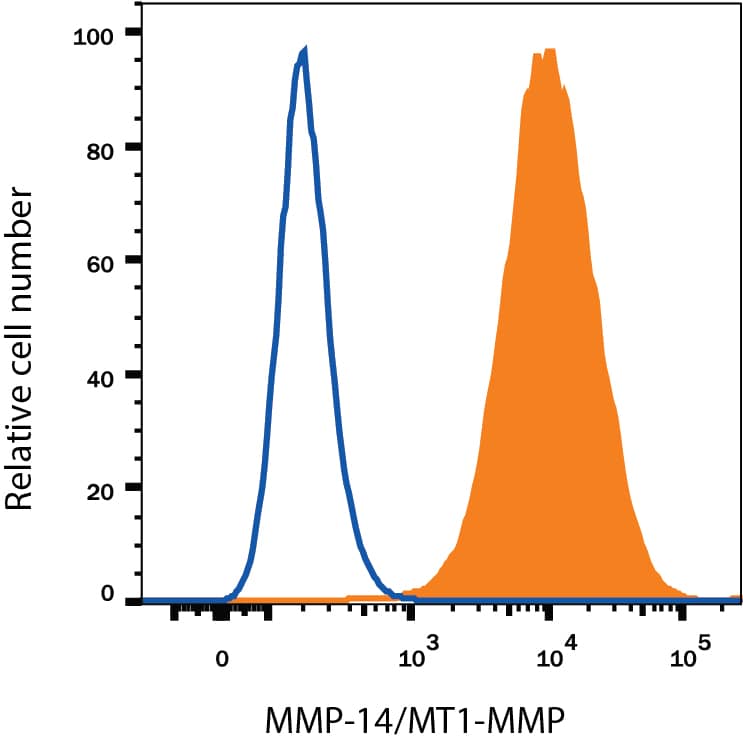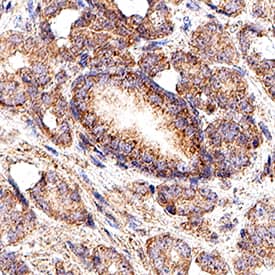Human MMP-14/MT1-MMP Antibody Summary
Tyr112-Ala541 (predicted)
Accession # P50281
Applications
Please Note: Optimal dilutions should be determined by each laboratory for each application. General Protocols are available in the Technical Information section on our website.
Scientific Data
 View Larger
View Larger
Detection of MMP-14/MT1-MMP in MDA‑MB‑231 Human Cell Line by Flow Cytometry. MDA-MB-231 human breast cancer cell line was stained with Mouse Anti-Human MMP-14/MT1-MMP Monoclonal Antibody (Catalog # MAB9181, filled histogram) or isotype control antibody (Catalog # MAB0041, open histogram), followed by Allophycocyanin-conjugated Anti-Mouse IgG Secondary Antibody (Catalog # F0101B).
 View Larger
View Larger
Detection of MMP‑14/MT1‑MMP in Human Prostate Cancer. MMP‑14/MT1‑MMP was detected in immersion fixed paraffin-embedded sections of Human Prostate Cancer using Mouse Anti-Human MMP‑14/MT1‑MMP Monoclonal Antibody (Catalog # MAB9181) at 15 µg/mL for 1 hour at room temperature followed by incubation with the Anti-Mouse IgG VisUCyte™ HRP Polymer Antibody (Catalog # VC001). Before incubation with the primary antibody, tissue was subjected to heat-induced epitope retrieval using VisUCyte Antigen Retrieval Reagent-Basic (Catalog # VCTS021). Tissue was stained using DAB (brown) and counterstained with hematoxylin (blue). Specific staining was localized to cytoplasm in epithelial cells. View our protocol for IHC Staining with VisUCyte HRP Polymer Detection Reagents.
Reconstitution Calculator
Preparation and Storage
- 12 months from date of receipt, -20 to -70 °C as supplied.
- 1 month, 2 to 8 °C under sterile conditions after reconstitution.
- 6 months, -20 to -70 °C under sterile conditions after reconstitution.
Background: MMP-14/MT1-MMP
As the first member of membrane type (MT) MMPs, MMP-14, also known as MT1-MMP, plays an important role in extracellular matrix (ECM) remodeling by being able to degrade type I collagen, activate pro-MMP-2 and process cell adhesion molecules such as CD44 and integrin alpha V (1). MMP-14 is therefore a key enzyme in many physiological and pathological processes such as angiogenesis and tumor invasion. Structurally, MMP-14 consists of the following domains: a pro domain containing the furin cleavage site, a catalytic domain containing the zinc-binding site, a hinge region, a hemopexin-like domain, a transmembrane domain, and a cytoplasmic tail (2).
Product Datasheets
Citations for Human MMP-14/MT1-MMP Antibody
R&D Systems personnel manually curate a database that contains references using R&D Systems products. The data collected includes not only links to publications in PubMed, but also provides information about sample types, species, and experimental conditions.
11
Citations: Showing 1 - 10
Filter your results:
Filter by:
-
RAB2A controls MT1-MMP endocytic and E-cadherin polarized Golgi trafficking to promote invasive breast cancer programs
Authors: Hiroaki Kajiho
EMBO Rep, 2016-06-02;0(0):.
-
Improved contractile potential in detrusor microtissues from pediatric patients with end stage lower urinary tract dysfunction
Authors: Gerwinn T, Salemi S, Schori LJ et al.
Frontiers in Cell and Developmental Biology
-
Syntaxin 7 contributes to breast cancer cell invasion by promoting invadopodia formation
Authors: S Parveen, A Khamari, J Raju, MG Coppolino, S Datta
Journal of Cell Science, 2022-06-28;135(12):.
Species: Human
Sample Types: Whole Cells
Applications: ICC -
A vasculature niche orchestrates stromal cell phenotype through PDGF signaling: Importance in human fibrotic disease
Authors: TB Layton, L Williams, N Yang, M Zhang, C Lee, M Feldmann, G Trujillo, D Furniss, J Nanchahal
Proceedings of the National Academy of Sciences of the United States of America, 2022-03-23;119(13):e2120336119.
Species: Human
Sample Types: Whole Cells, Whole Tissue
Applications: CyTof, IHC -
Cellular census of human fibrosis defines functionally distinct stromal cell types and states
Authors: TB Layton, L Williams, F McCann, M Zhang, M Fritzsche, H Colin-York, M Cabrita, MTH Ng, M Feldmann, SN Sansom, D Furniss, W Xie, J Nanchahal
Nat Commun, 2020-06-02;11(1):2768.
Species: Human
Sample Types: Whole Cells
Applications: CyTof -
Localization, Shedding, Regulation and Function of Aminopeptidase N/CD13 on Fibroblast like Synoviocytes
PLoS ONE, 2016-09-22;11(9):e0162008.
Species: Human
Sample Types: Whole Cells
Applications: IHC-Fr -
Selective blockade of matrix metalloprotease-14 with a monoclonal antibody abrogates invasion, angiogenesis, and tumor growth in ovarian cancer.
Authors: Kaimal R, Aljumaily R, Tressel S, Pradhan R, Covic L, Kuliopulos A, Zarwan C, Kim Y, Sharifi S, Agarwal A
Cancer Res, 2013-02-19;73(8):2457-67.
Species: Human
Sample Types: Whole Cells
Applications: Flow Cytometry -
Contractile forces contribute to increased glycosylphosphatidylinositol-anchored receptor CD24-facilitated cancer cell invasion.
Authors: Mierke CT, Bretz N, Altevogt P
J. Biol. Chem., 2011-08-02;286(40):34858-71.
Species: Human
Sample Types: Whole Cells
Applications: Flow Cytometry -
Integrin alpha5beta1 facilitates cancer cell invasion through enhanced contractile forces.
Authors: Mierke CT, Frey B, Fellner M, Herrmann M, Fabry B
J. Cell. Sci., 2011-01-11;124(0):369-83.
Species: Human
Sample Types: Whole Cells
Applications: Flow Cytometry -
GPI-anchored TIMP-1 treatment renders renal cell carcinoma sensitive to FAS-meditated killing.
Authors: Djafarzadeh R, Noessner E, Engelmann H
Oncogene, 2006;25(10):1496-508.
Species: Human
Sample Types: Cell Culture Supernates
Applications: Western Blot -
Inhibition of the invasion and metastasis of mammary carcinoma cells by NBD peptide targeting S100A4 via the suppression of the Sp1/MMP‑14 axis
Authors: Keizo Takenaga, Takahiro Ochiya, Hideya Endo
International Journal of Oncology
FAQs
No product specific FAQs exist for this product, however you may
View all Antibody FAQsReviews for Human MMP-14/MT1-MMP Antibody
There are currently no reviews for this product. Be the first to review Human MMP-14/MT1-MMP Antibody and earn rewards!
Have you used Human MMP-14/MT1-MMP Antibody?
Submit a review and receive an Amazon gift card.
$25/€18/£15/$25CAN/¥75 Yuan/¥2500 Yen for a review with an image
$10/€7/£6/$10 CAD/¥70 Yuan/¥1110 Yen for a review without an image
